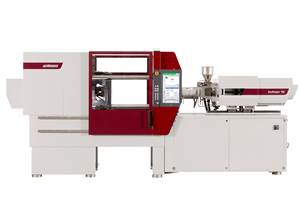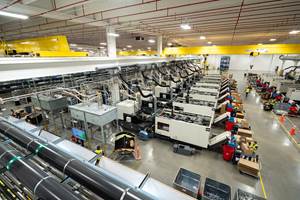Optimizing Your Molding Cycle
It is possible for machines to run too fast—find the sweet spot where maximum output overlaps with good parts.
It is possible for machines to run too fast—find the sweet spot where maximum output overlaps with good parts.
In today’s fast paced plastic injection industry, lean manufacturing is a primary driver of profitability. Without lean, organizations find their operations are sluggish and ineffective. This not only affects a company’s ability to successfully grow and prosper, but the capability of taking on new work also suffers because current systems have not been effectively streamlined. This article addresses cycle time optimization, outlining the different variables within the molding process that can be used to maximize profits.
One of the first points that needs to be made when addressing this topic is to acknowledge that it is possible for machines to run too fast. Every molding job is different, and the following conditions must be satisfied to properly assure that the optimization is successful:
- Quality is key to the integrity of every molding operation. Running too fast to provide adequate operator inspection defeats the purpose of effective production. Rework and scrap reduce productivity, so steps must be taken to assure that quality is not affected by optimization.
- Keep optimization tactics real and consider potential failures that could occur due to optimization. For instance, knocking 10 seconds off of a job molding nylon parts sounds fantastic, but if the lower cooling time increases shrinkage, it could potentially throw parts out of spec dimensionally.
- During the optimization process, be vigilant to make adjustments slowly. When changes are made to the process in clusters, make the adjustments and then allow ample time for changes to take effect. Then take sample parts for part layout and PUT THE SETTINGS BACK until the parts and process have been validated. Sample runs should always be run separately from production as a means to prevent suspect parts from getting to the customer.
Following the steps above helps to prevent costly errors that can occur with poorly planned optimization events. Optimization is a fantastic tool when properly applied to your molding operation, but only with the understanding that proper approach is crucial to the success of continuous improvement.
The following list outlines many of the parameters that can be considered when reducing the cycle time of a molding operation:
Cooling Time: Cooling time is one of the easiest avenues of optimizing your cycle. In most molding scenarios, cooling time is set 1.5 to 2 seconds longer than screw rotate time. It is important to point out that there are situations that may require a longer cooling cycle (such as dimensional requirements or parts sticking), but as a general rule screw rotate time establishes cooling time.
Hold Time: Hold Time is another major contributor to maximizing cycle time. The best method of accomplishing this is through a gate-seal study. Gate seal is the amount of required hold time needed to cool the runner tip into stasis. This prevents plastic from leaking back out of the runner, which leads to molding inconsistencies.
Performing a gate seal study is simple—once a decoupled process has been established, set the hold time well above what is generally common for the material and part size you are working with. While running, make reductions to the hold time and weigh each part as it relates to the change. Watch for a weight reduction, and when part weight drops, add 1 second back to the hold time and the test is complete.
Fill Time: Fill time is another parameter that affects cycle time. Injection speed controls how fast or slow the resulting fill time is. Of course, the type of material and mold complexity put constraints on fill time. Based on this, the goal of optimizing fill time is to shoot material as quickly as possible without affecting the aesthetics and functionality of the parts being produced.
Melt Temperature: When setting up a process, using minimal temperature helps reduce cooling time, which in turn, helps improve cycle time. It is important to note that every processing approach is different, so the higher viscosity of a lower melt temperature could lead to defects. Start your process at the lower end of the melt window, and as you make adjustments, raise temperatures until you achieve process stability.
Mold Temperature: Mold temperature also affects cooling time. When establishing mold temperature, start at the lower end of normal processing recommendations from the material manufacturer. Higher temperatures might be required to improve aesthetics, and even part removal. Mold temperature also affects dimensional properties, so this needs to be taken into consideration.
Back Pressure: Higher back pressure increases screw rotate time, which can affect minimum cooling time. Use enough back pressure to achieve melt consistency, but keep it as low as possible to reduce screw rotate time.
Mold Open/Mold Close: Maximize mold open and close speeds to reduce mold open time. Here it is important to note that mold breakaway and mold close speeds are affected by the complexity of slides, horn pins, etc. so make safe operations of your molds the first priority as you set them up. In addition, watch low pressure close—you want to keep it as low as possible for mold protection, but remember that with speed/pressure set too low, they can add to overall cycle time. Again: safety and mold protection take first priority over optimization.
Ejection: Improper ejection set up can adversely affect cycle time. During ejection set up, use only the amount of stroke you need to remove the part safely without the part sticking in the mold. Ejection speed and pressure are also important to faster ejection time, but it is important to note that when increasing speed/pressure set points, watch for pin push or cracking. Minimal pressure and maximum speed will generally produce the optimum result.
Robot: Robot function also affects cycle. There are two primary effects that can be optimized. First, the robot needs to get in and out of the mold quickly to prevent an increase of mold open time. Second: the robot must be in position waiting for the mold to open. When possible, establish the robot “wait ” position as low on the “Y” axis as possible to improve the extraction time.
Lean manufacturing requires continuous improvement and maximized efficiencies. When cycle optimization is complete, the resulting process will produce the highest yield, minimum to zero scrap, and greatly reduced down time. It is important to remember that the primary goal of optimization is to achieve full efficiency while still maintaining world-class quality parts. Through careful and meticulous approach, process optimization is an effective tool in the movement towards lean manufacturing.
Garrett MacKenzie is the owner and editor of www.plastic411.com. Mackenzie started in plastics at the age of 19 as an operator, eventually moving up through the ranks to engineering and management over a 29-year timeframe. He currently works as a plastic injection consultant in engineering and training capacities. He can be contacted at garrett.mackenzie@mail.com.

Related Content
Fakuma 2023: Wittmann Battenfeld Expands All-Electric Line, Direct-Current Capabilities
Wittmann Battenfeld will introduce the new EcoPower B8X injection molding machine line and show direct current as an energy source for a concept machine that will power its own robot.
Read MoreNext-Generation All-Electric and Vertical Injection Molding Machines
Sodick Plustech’s VR-G and MS-G2 Series both utilize the company’s proprietary V-Line technology, separating plasticizing and injection functions, and have upgraded displays, energy efficiency, response time and more.
Read MoreConsistent Shots for Consistent Shots
An integral supplier in the effort to fast-track COVID-19 vaccine deployment, Retractable Technologies turned to Arburg and its PressurePilot technology to help deliver more than 500 million syringes during the pandemic.
Read MoreIPEX Opens Injection Molding Facility in North Carolina
The pipe and fittings manufacturer’s new 200,000-square-foot facility represents a $200 million investment and will create 150 jobs.
Read MoreRead Next
Lead the Conversation, Change the Conversation
Coverage of single-use plastics can be both misleading and demoralizing. Here are 10 tips for changing the perception of the plastics industry at your company and in your community.
Read MoreMaking the Circular Economy a Reality
Driven by brand owner demands and new worldwide legislation, the entire supply chain is working toward the shift to circularity, with some evidence the circular economy has already begun.
Read More



























